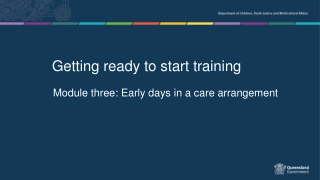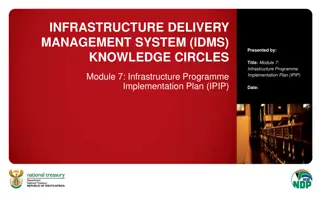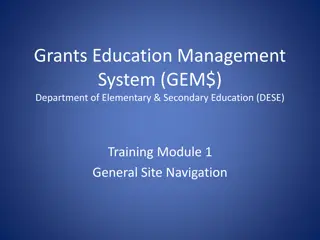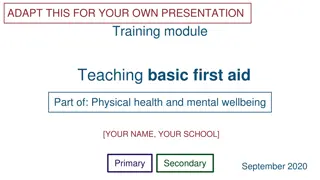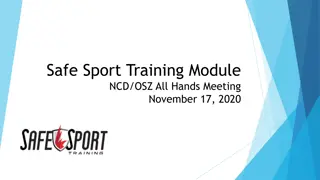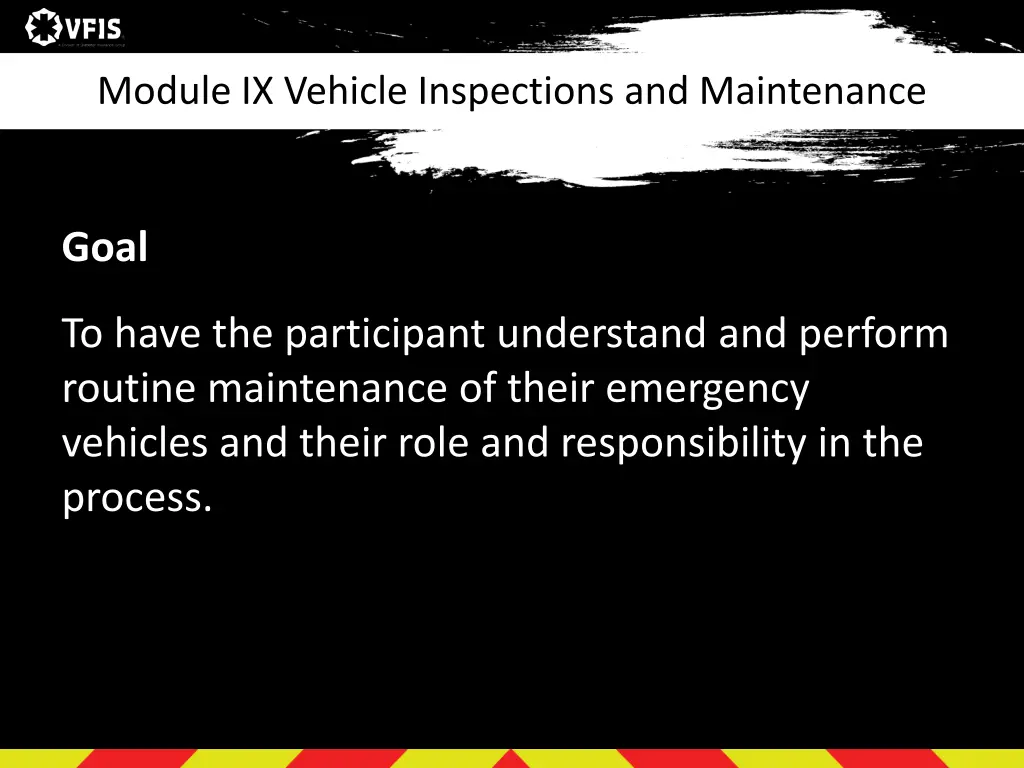
Emergency Vehicle Inspections and Maintenance Guide
This comprehensive guide covers the value of regular vehicle inspections, major component systems of emergency vehicles, pre- and post-trip inspection procedures, preventive maintenance types, driver responsibilities, record-keeping importance, and detailed information on emergency vehicle components like chassis, body, and auxiliary systems. It also includes checklists for post-trip inspections and pre-trip checks to ensure the safe operation of emergency vehicles.
Download Presentation

Please find below an Image/Link to download the presentation.
The content on the website is provided AS IS for your information and personal use only. It may not be sold, licensed, or shared on other websites without obtaining consent from the author. If you encounter any issues during the download, it is possible that the publisher has removed the file from their server.
You are allowed to download the files provided on this website for personal or commercial use, subject to the condition that they are used lawfully. All files are the property of their respective owners.
The content on the website is provided AS IS for your information and personal use only. It may not be sold, licensed, or shared on other websites without obtaining consent from the author.
E N D
Presentation Transcript
Module IX Vehicle Inspections and Maintenance Goal To have the participant understand and perform routine maintenance of their emergency vehicles and their role and responsibility in the process.
Module IX Vehicle Inspections and Maintenance Objectives Explain the value and importance of regular vehicles inspections. Identify the major component systems of an emergency vehicle. Describe how to perform pre- and post-trip inspections.
Module IX Vehicle Inspections and Maintenance Objectives (Cont d) List the three types of preventive maintenance. Explain the role of the emergency vehicle driver in performing certain vehicle inspections and maintenance functions. Describe the importance of keeping accurate and complete records.
Emergency Vehicle Components Chassis Body Primary Function Components (task or mission) Auxiliary Systems
Emergency Vehicle Components Chassis Frame Suspension System Steering and Braking Systems Power Train Components
Emergency Vehicle Components Body Primary Function Auxiliary Systems
Inspections Post-Trip Cleaning of Vehicle Replacing Supplies Inventory Equipment Re-fueling and Checking Fluid Levels, If Justified Report Any Unusual Occurrences or Malfunctions PM Fill-In
Inspection Checklist Pre-trip Vehicle Overview Check the Engine Compartment Start Engine and Check Inside Cab Check Headlights, Signal Lights, Warning Lights, and Audio Devices Conduct Walk Around Inspection Check Controls and Indicators Check Brake System (air brakes)
PRE-TRIP INSPECTION CHECKLIST
Pre-Trip Inspection Checklist Vehicle Overview Look at general condition Check windshield for damage and it is clean Look for damage and whether the vehicle is leaning Check under the vehicle for fresh oil, coolant, grease or fuel leaks Review vehicle log
Pre-Trip Inspection Checklist Check engine compartment Verify parking brake is engaged Check engine oil level Coolant level and condition of hoses Power steering fluid
Pre-Trip Inspection Checklist Check engine compartment (cont d) Windshield washer fluid Belts for tightness and wear Leaks in engine compartment Battery fluid level and connections Automatic transmission fluid level
Pre-Trip Inspection Checklist Start engine Listen for noises Verify gauges are within normal ranges Check any warning lights and/or buzzers
Pre-Trip Inspection Checklist Check gauges & warning lights Coolant temp. gauge Voltmeter Tachometer Speedometer Fuel level gauge Transmission oil temp Compound air pressure
Pre-Trip Inspection Checklist Check inside cab Check operations of vehicle controls Steering wheel Accelerator Brakes (parking, service, secondary braking system) Transmission
Pre-Trip Inspection Checklist Check inside cab (Cont d) Check operations of vehicle controls (Cont d) Horn(s) Windshield wiper/washer Light switches and indicators Mirrors Seat adjustments/seatbelts
Pre-Trip Inspection Checklist Check headlights, signal lights, warning lights and audio devices Running, parking and brake lights Turn signals and four-way flashers Headlights (low and high beams) Warning lights Work lights (front, rear, intersection, side and others)
Pre-Trip Inspection Checklist Conduct walk-around inspection Left front wheel and tire for condition, tread and inflation and the left front suspension Windshield, wipers, washer, front bumper and cleanliness of audio devices, lamps and reflectors Right front wheel and tire for condition, tread and inflation and the right front suspension
Pre-Trip Inspection Checklist Conduct walk-around inspection (Cont d) Cab doors and closure, vehicle body, special body provisions such as pump panel, patient compartment door, equipment and storage compartments and doors Right rear wheels and tires for condition, tread and inflation and the right rear suspension
Pre-Trip Inspection Checklist Conduct walk-around inspection (Cont d) Hose bed, rear patient compartment doors and other body features (specific to the vehicle being inspected), lamps and reflectors Left rear wheel and tire for condition, tread and inflation and the left rear suspension and fuel fill
Pre-Trip Inspection Checklist Conduct walk-around inspection (Cont d) All compartments and cab doors, all closures, vehicle body Operator s position specific to the vehicle being inspected such as pump pane. capes, valves, drains and equipment
Pre-Trip Inspection Checklist Check controls and indicators at operator s position or any other or any other special function, components, wherever located Check engine controls and indicators, pump controls and indicators, pump panels lights and other controls specific to the vehicle being checked.
Pre-Trip Inspection Checklist Check brake system (air brakes) Test low pressure warning signal Check to ensure that spring brakes come on automatically Check the rate of air pressure buildup Test the air leakage rate Test the parking brake Test the service brake
Pre-Trip Inspection Checklist Fixed equipment Cab lift controls Ladder controls Cable reels Radio equipment Other permanently affixed items
Practical Application Time to get up and moving Provided a copy of vehicle checklist Demonstrate vehicle check
Preventive Maintenance Benefits Safety Costs Operational Effectiveness Liability Basis for Purchasing Decisions
Types of Preventive Maintenance Routine Maintenance Scheduled Maintenance Crisis Maintenance PM Fill-In
Types of Preventive Maintenance Routine Fluid Level Checks Wheels and Tires Electrical Systems and Devices
Types of Preventive Maintenance Scheduled Manufacturer s Recommended Schedule Amount of Use (example: Regeneration Process) Organizational Policy Professional Standards
Types of Preventive Maintenance Crisis Classification A (immediate) Classification B (as soon as possible) Classification C (next P.M.) PM Fill-In
Role of the Emergency Vehicle Driver Battery or Batteries Braking System Coolant System Electrical System Fuel Hydraulic Fluids
Role of the Emergency Vehicle Driver Lubrication Oil (engine) Tires Steering System Belts Tools, Appliances, and Equipment
Role of the Emergency Vehicle Driver Document the need for maintenance on the assigned vehicle Verify that the requested and needed maintenance was performed Follow established departmental guidelines for taking the vehicle out of service
NFPA 1911 Out of Service Criteria A. Identify apparatus out of service Sign on outside of door Special bag that covers steering wheel Large sign on driver s window
NFPA 1911 Out of Service Criteria (Contd) B. Identify components out of service Distinctive color sign located on the inside of the driver s door identifying which component Highly visible device provided at the components control(s)
NFPA 1911 Out of Service Criteria (Contd) C. Driving and Crew Area Cracked or broken windshield Missing or broken door latches Seats without seatbelts, damaged seatbelts, or missing or broken buckles Broken wipers or foot throttle
NFPA 1911 Out of Service Criteria (Contd) D. Chassis, suspension driveline, wheels and axles GAWR that exceeds manufacturer s load rating for any tire Weight that exceeds the GAWR for that axle Actual overall weight that exceeds GVWR or GCWR
NFPA 1911 Out of Service Criteria (Contd) D. Chassis, suspension driveline, wheels and axles Tires with cuts to the cords Front tires with less than 4/32 inch tread or rear tires with less than 2/32 inch tread at two adjacent major tread grooves anywhere on the tire Wheels or rims damaged Weld cracks
NFPA 1911 Out of Service Criteria (Contd) E. Engine systems Engines that won t crank or start Engines that are overheating Leaking of fuel Excessive leaking of oil Oil that contains coolant Oil that is diluted with fuel Stop-engine light that fails to turn off
NFPA 1911 Out of Service Criteria (Contd) F. Engine cooling system Coolant system leak Coolant that contains oil Cooling system that exceeds max. operating temperature
NFPA 1911 Out of Service Criteria (Contd) G. Transmission and clutch Automatic transmission that overheats in any range Automatic transmission that has a do not shift light on Transmission components that are leaking transmission oil
NFPA 1911 Out of Service Criteria (Contd) H. Low voltage and line voltage electrical systems Legally required lighting or horn not operational Ignition system not operational Charging system not operational Failure of warning lights that creates any position around the apparatus from which no warning light is visible Inoperative siren (OOS for emergency response) Damaged receptacles or other observed shock hazards
NFPA 1911 Out of Service Criteria (Contd) I. Braking Systems (Air) Service brakes that have a air pressure drop of more than 2 psi in 1 min. or a straight chassis or more than 3 psi in 1 min. for a combination chassis, with the engine stopped and the service brake released. Brakes that are out of adjustment ABS warning indicator (light) activated
NFPA 1911 Out of Service Criteria (Contd) I. Braking Systems (Air) (Cont d) Braking systems that are not operational Air compressor that fails to build up pressure in accordance with manufacturer s min. specifications Air compressor failure to maintain 80 to 90 psi pressure in accordance with manufacturer s min. specifications Brake shoes or disk brake pads that have grease or oil on them
NFPA 1911 Out of Service Criteria (Contd) I. Braking Systems (Air) (Cont d) Rotors and/or drums that are worn beyond manufacturer s min. specifications Brake linings or pads worn beyond manufacturer s min. specifications Air gauge or audio low-air warning device failure
NFPA 1911 Out of Service Criteria (Contd) J. Braking Systems (Hydraulic) Leaking brake fluid Brake shoes or disc brake pads that have grease or oil on them Braking systems not operational Braking systems that do not meet tests or standards ABS warning indicator (light) activated
NFPA 1911 Out of Service Criteria (Contd) J. Braking Systems (Hydraulic) (Cont d) Parking (service brake) that does not meet tests or standards Brake warning light that is activated or brake pedal that falls away or drifts toward floor when brake pressure is applied Brake linings, pads, rotors, drums that do not meet manufacturer s min. specifications Rotors and/or drums that are worn beyond manufacturer s min. specifications


